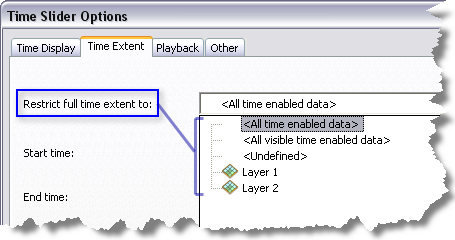Full Time Extent of the time slider
Full Time Extent of the time slider defines the time period on the timeline within which you can visualize your time-enabled data using the Time Slider Control.
You can choose to visualize a smaller time range within the full time extent by modifying the start time and end time of the time slider. However, the start time and end time of the time slider have to be within the full time extent.
By default, the full time extent of the time slider is the cumulative time extent of all the time-enabled datasets in the current map, globe, or scene. However, you can choose to set the full time extent to be based on the extent of only the visible time-enabled datasets or on an individual time-enabled dataset in your map, globe, or scene. You can also choose to set the full time extent to a time period of your own choice.
The full time extent for the time slider can be set on the Time Extent tab of the Time Slider Options dialog box. The full time extent defined here is used when the Full Time Extent button  is clicked on the Time Slider window.
is clicked on the Time Slider window.

Restricting the full time extent to all time-enabled data
By default, the full time extent of the time slider is set to the cumulative time extent of all time-enabled data in the current map, globe, or scene. Choosing this option sets the full time extent of the time slider to be based on the minimum and maximum time of all the time-enabled datasets (visible or invisible in the table of contents).
Say you have two time-enabled datasets—Layer 1 and Layer 2. Layer 1 has a time extent from January 1 to January 10, and Layer 2 has a time extent from January 8 to January 15. Restricting the full time extent to all time-enabled datasets will set the full time extent of the time slider to January 1 to January 15.
Restricting the full time extent to all visible time-enabled data
You can choose to set the full time extent of the time slider to the time extent of all visible time-enabled datasets in the current map, globe, or scene. Choosing this option sets the full time extent of the time slider to be based on the minimum and maximum time of all the visible time-enabled datasets (visible in the table of contents).
Say you have two time-enabled datasets—Layer 1 and Layer 2. Layer 1, which is visible in the table of contents, has a time extent from January 1 to January 15, and Layer 2, which is invisible in the table of contents, has a time extent from January 10 to January 25. Restricting the full time extent to all visible time-enabled datasets will set the full time extent of the time slider to January 1 to January 15.
Restricting the full time extent to an individual time-enabled layer
You can choose to restrict the time extent to that of a time-enabled layer in the current session. Choosing this option sets the full time extent of the time slider based on the minimum and maximum time of the time-enabled dataset you choose.
Say you have two time-enabled datasets—Layer 1 and Layer 2. Layer 1 has a time extent from January 1 to January 15, and Layer 2 has a time extent from January 10 to January 25. Restricting the full time extent to Layer 2 will set the full time extent for the time slider to January 10 to January 25.
Setting an undefined full time extent
If you do not want the full time extent of the time slider to be restricted to a period of time defined by the time-enabled layers, you can set the full time extent to Undefined. This option allows you to set the full time extent to any time period on the timeline. Using this option, you can set start time and end time on the time slider to any time on the timeline.
This is useful in cases when you want to visualize time-enabled data during a specific period of interest on the timeline. Say you have a time-enabled layer (Layer 1) with the crime incidents for the month of January 2010. If there were no incidents that took place from January 1 to January 5 based on the time values in the data, by default, the time slider's full time extent would be set to January 5 to January 31. However, using the undefined full time extent, you can choose to set the full time extent to be from January 1 to January 31. This can be done by specifying values for Start time and End time on the Time Extent tab of the Time Slider Options dialog box.
Learn more about setting the start and end time of the time slider
Having an undefined full time extent option also allows you to scroll across the timeline without any restrictions.
Learn more about scrolling back and forward in time on the time slider
Steps to set the full time extent of the time slider
- Open the Time Slider window by clicking the Time Slider button
 on the Tools toolbar.
on the Tools toolbar.
- Click the Options button
 to open the Time Slider Options dialog box. Click the Time Extent tab.
to open the Time Slider Options dialog box. Click the Time Extent tab.
- From the Restrict full time extent drop-down list, specify the way you want to restrict the full time extent of the time slider.
The start time and the end time values of the time slider change based on the option you choose.